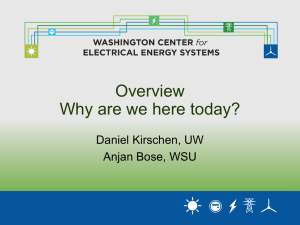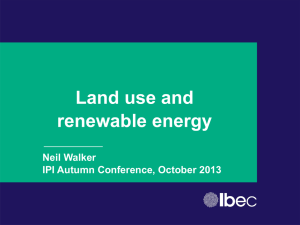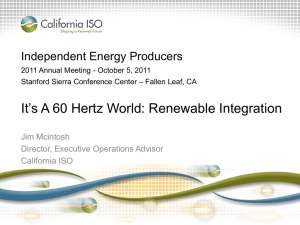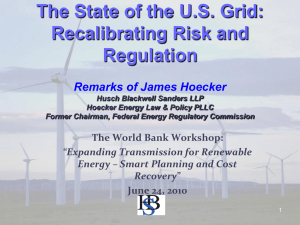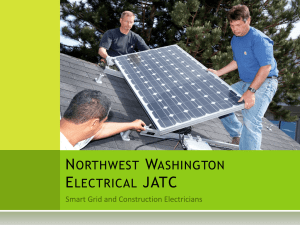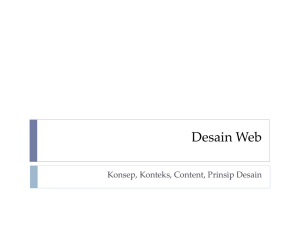GTSP II Program Plan and Deliverables
advertisement
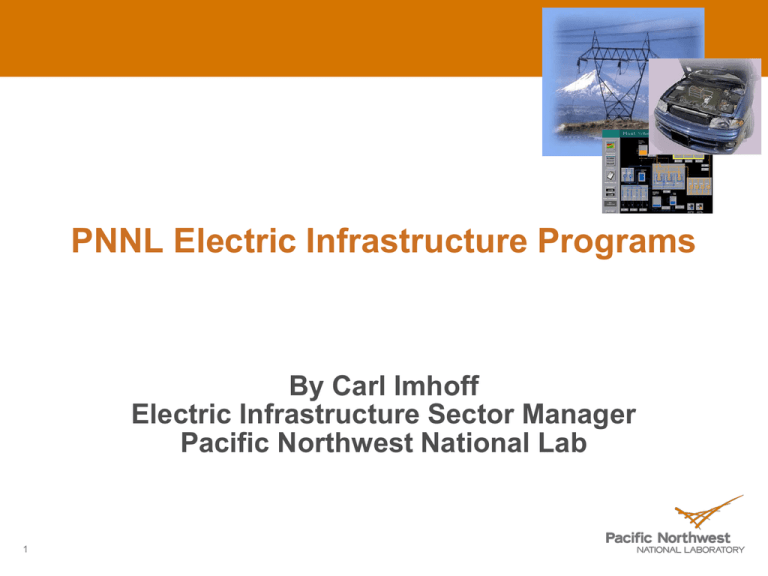
PNNL Electric Infrastructure Programs By Carl Imhoff Electric Infrastructure Sector Manager Pacific Northwest National Lab 1 About Pacific Northwest National Laboratory PNNL FY2010 Snapshot $1.1 billion in R&D More than 4,900 staff and a payroll of more than $410 million Voted one of Washington’s best places to work 930 peer-reviewed publications 46 patents issued Ranked 43rd on InformationWeek’s 500 most innovative users of business information technology Strengthen U.S. Scientific Foundations for Innovation Prevent and Counter Acts of Terrorism and the Proliferation of Weapons of Mass Destruction 2 Increase U.S. Energy Capacity and Reduce Dependence on Imported Oil Reduce Environmental Effects of Human Activity and Create Sustainable Systems Energy and Environment Business FY10 Sales: $365 million Business areas include: Clean Fossil Energy Electricity Infrastructure Energy Efficiency and Renewable Energy Environmental Health and Remediation Nuclear Energy Nuclear Regulatory The challenge ahead is complex The grid must meet new expectations The energy industry is highly regulated, capital intensive, risk averse, innovation poor and highly fragmented Historical Expectations Affordable Power Reliable Power Secure Power Emerging Expectations Delivering 300 GW of renewable generation by 2025 Maximize benefits of end-use efficiency and storage Electrify transportation sector to reduce dependence on imported oil Meet future carbon and emissions constraints 3 3 Today data is limited to traditional boundaries Transparency is moderate at high voltage….virtually nonexistent at the consumer end • 6 second SCADA for EMS • < 200 phasors © 2010 PNNL 4 4 • 6 second SCADA for DMS • Manual (mostly) control & outage monitoring • Limited self monitoring • Limited price signal • Limited options How might the grid of the future be different? Real-time, time-synchronous data pervasive across the system • • • • Phasor measurement nets High-resolution protective relays Distribution automation data Digital, 2-way end use data © 2010 PNNL • • • 5 5 End-to-end view of status enables running the system closer to optimum Incentives and opportunities can be viewed end-to-end to better meet objectives New paradigms for design and control enabled - Higher (n-x) design criteria - Adaptive protection and control - Use of demand response for ancillary services Transforming the U.S. Energy System PNNL’s Electric Infrastructure Research Agenda System Transparency – Seeing and operating the grid at the interconnection level in real-time Analytic Innovations - Leveraging High-Performance Computing and new algorithms to provide real-time situational awareness and models for prediction and response End-Use Efficiency and Demand Response – Making demand an active tool in managing grid efficiency and reliability. Renewable Integration – Addressing variability and intermittence of large-scale wind generation and the complexities of distributed generation and net metering Energy Storage – Defining the location, technical performance, and required cost of storage; synthesizing nanofunctional materials and system fabrication to meet requirements 6 6 Cyber Security and Interoperability – Defining standards for secure, two-way communication and data exchange Advanced Visualization and Decision Support Tools R&D Wide Area Hybrid Grid Health Tool Small Signal Analysis Tool Severe Disturbance Visual views of RT Grid Security 7 NVAC Power System View Battelle-led Pacific Northwest Demonstration Project will explore smart grid functionality $178M, ARRA-funded, 5-year demonstration 60,000 metered customers in 5 states Quantify costs and benefits Facilitate integration of wind and other renewables Led by Battelle and partners including BPA, 12 utilities, 2 universities, and 5 vendors Will utilize PNNL’s Electricity Infrastructure Operations Center Key 8 Demand Response Distributed Generation Energy Storage Grid Friendly Appliance Renewables Integration Tech/Data Testing GridLAB-D: Design Tool for the Smart Grid Unifies models of the key elements of a smart grid: Power Systems Loads Markets Smart grid analyses field projects technologies control strategies cost/benefits Time scale: sec. to years Open source Contributions from government industry academia Vendors can add or extract own modules GridLAB-D is a DOE-funded, open–source, time-series simulation of all aspects of operating a smart grid from substation level down in unprecedented detail Simultaneously solves 1) power flow, 2) end use load behavior in 1000s of homes, and 3) doubleauction markets to set real-time 9 These multi-disciplinary analyses cannot be produced by any other simulation in the world! Renewables Integration Industry Challenges Predicting wind ramps Meeting regulation/load following needs Managing overgeneration conditions Impact of regulation requirements on hydro units Better prediction of “tail” events such as Texas in spring 2008 10 PNNL Strategy to Enable 25% by 2025 Have a significant impact on national energy needs and green house gas emissions Transform variable resources into semi-firm electricity Be cost acceptable in the short run and cost effective in the long run Electrical energy storage for utility applications 11 Develop cost-effective electrochemical energy storage technologies or batteries to enable significant renewable integration and smart grid i. High performance, low cost redox flow batteries; ii. Novel Na-solid oxide batteries in planar design iii. Unique Li-ion batteries for community storage Establish grid storage analytics that evaluate the value storage plays at different levels of the system at what price and performance levels Trends Impacting Control System Security Trends Cyber Security Elements Open Protocols Confidentiality Common Operating Systems Integrity Interconnected to Other Systems Availability Reliance on Public Communications Increased Capability of Field Equipment Control systems have specific requirements & priorities! 12 Regional Needs and Offerings High renewable penetration + hydro base offer unique needs and values Regional investment and leadership in emerging digital concepts calls for coordinated research and thought leadership Regions legacy in coordinated efficiency + emissions profiles point to priority on electrifying transportation to impact carbon agenda How can region leverage innovations at high and low voltage to lead grid modernization in ways that engage and delight the consumers? How do we go beyond improving current paradigms to illuminate potential of new grid operational paradigms? 13


